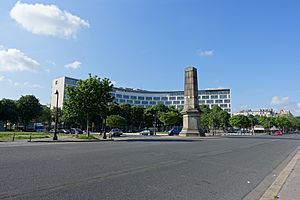Beverly Lorraine Greene facts for kids
Quick facts for kids
Beverly Lorraine Greene
|
|
|---|---|
 |
|
| Born | October 4, 1915 Chicago, Illinois, U.S.
|
| Died | August 22, 1957 (aged 41) New York City, U.S.
|
| Alma mater | University of Illinois at Urbana–Champaign |
| Occupation | Architect |
| Known for | First female African-American licensed architect in the US |
Beverly Lorraine Greene (born October 4, 1915 – died August 22, 1957) was an amazing American architect. Many believe she was the first African-American woman to become a licensed architect in the United States. She officially registered as an architect in Illinois in 1942.
Biography
Beverly Lorraine Greene was born in Chicago, Illinois, on October 4, 1915. Her parents were James A. Greene, an attorney, and Vera Greene. Beverly was their only child.
She went to the University of Illinois at Urbana–Champaign (UIUC). This university allowed students of all races to study together. In 1936, she earned a bachelor's degree in architectural engineering. She was the first African-American woman to get this degree from UIUC. A year later, she earned her master's degree in city planning and housing. She also enjoyed being part of the drama club called Cenacle.
Starting Her Career
After finishing her studies, Beverly moved back to Chicago. In 1937, she started working for Kenneth Roderick O'Neal's architecture firm. This was the first architecture office in downtown Chicago led by an African American. In 1938, she joined the Housing Authority.
On December 28, 1942, Beverly Greene became the first licensed African-American woman architect in the United States. She registered with the State of Illinois. Even with her impressive skills, it was hard for her to find work because of racial barriers. Mainstream newspapers in Chicago often ignored her and other black architects.
Moving to New York
In 1945, Beverly read about a big building project in New York City called Stuyvesant Town. She decided to apply to help design it, even though the project had plans for segregated housing. To her surprise, she was hired!
After only a few days, she left that job. She received a scholarship to study for another master's degree at Columbia University. In 1945, she earned her master's degree in architecture.
She then started working for the firm of Isadore Rosefield. This firm mainly designed buildings for health facilities. Beverly worked there until 1955. During this time, she also worked with famous architect Edward Durell Stone on some projects. In 1951, she helped with the theater project at the University of Arkansas. In 1952, she helped plan the Arts Complex at Sarah Lawrence College.
After 1955, she worked with another well-known architect, Marcel Breuer. She helped design the UNESCO United Nations Headquarters in Paris. She also worked on some buildings for the University Heights Campus of New York University. Sadly, both of these big projects were finished after Beverly's death.
Beverly Lorraine Greene passed away on August 22, 1957, in New York City. She was 41 years old. Her memorial service was held at the Unity Funeral Home in Manhattan, a building she had designed herself.
Projects
Beverly Lorraine Greene worked on many important projects. Here are some she worked on with Marcel Breuer:
- Grosse Point Public Library, Grosse Point, Michigan, 1951
- Winthrop House Rockefeller addition, Tarrytown, New York, 1952
- UNESCO Headquarters, Secretariat and Conference Hall, Paris, 1954–57
- New York University Building Complex, University Heights campus, Bronx, New York, 1956
See also
 In Spanish: Beverly Loraine Greene para niños
In Spanish: Beverly Loraine Greene para niños

